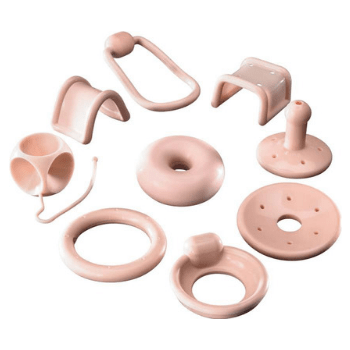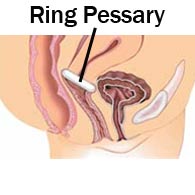
Pessaries are a great alternative to prolapse surgery for many women.
Are you seeking to avoid prolapse surgery?
Do you want to reduce your prolapse symptoms?
Pessaries have been used for centuries by women seeking to manage pelvic prolapse.
The hand carved antique bone pessary (shown right) dates back to the 1860’s and is similar to some of our modern day pessaries.
Read on now to learn:
- What are pessaries
- When to use a pessary
- How pessaries work
- Benefits of using a pessary
- How to get a pessary fitted
- How a well fitting pessary feels
- How to know if your pessary fits
- Vaginal oestrogen and pessary use
- When to avoid using a pessary
- When a pessary is less effective?
- Side effects of pessaries
- Sex and pessary
Prolapse Exercises e-Book
International best selling prolapse exercise guide for women with prolapse and after prolapse surgery.
Prolapse Exercises teaches you how to:
- Exercise safely after prolapse surgery
- Reduce your risk or repeat prolapse
- Avoid unsafe exercises
- Choose pelvic floor safe exercises
- Reduce your risk of prolapse worsening
- Improve prolapse support
- Increase your strength and fitness
- Strengthen your core
- Lose weight
What are Pessaries?
A pessary for pelvic organ prolapse is a device that is inserted high within the vagina.
Pessaries are designed to support the collapsed walls of the vagina and the prolapsed organs i.e. bladder, bowel and/or uterine prolapse
Modern day pessaries come in a wide range of shapes, sizes and different designs (shown right).
A support pessary is quite different from a pessary or tablet/capsule that is inserted into the vagina to delivery medication to the pelvic floor (e.g. vaginal oestrogen pessary).
Vaginal pessary devices have been used by women for thousands of years.
Reports of pessary use date back to ancient Egypt.
Over the ages women have used a variety of materials to make pessaries including fruit (pomegranates), stones, soaked cloth, cork, brass and rubber.
These days most pessaries are made from medical grade silicone or plastic which are readily cleaned and non absorbent.
When to use a Pessary
Women may use a support pessary to support their prolapse for a number of reasons including:
- A desire to avoid or delay prolapse surgery
- To allow exercise with a prolapse
- Early stage prolapse
- Desire for future pregnancy
- During pregnancy or following childbirth
- When unsuitable for pelvic prolapse surgery
- Previous failed prolapse surgery
- To manage stress incontinence and prolapse
- During pelvic floor muscle rehabilitation for prolapse
- With advanced age.
It’s surprising that more pessaries are not fitted to help women exercise and avoid prolapse symptoms with exercise.
Overweight women struggling to improve their pelvic floor strength and prolapse support are another group who might benefit from the added support of a pessary.
How Does a Pessary Work? 
A pessary provides a mechanical or physical support to hold up the prolapsed tissues within the vagina.
Pessaries work by lifting the walls of the vagina and providing support for the bladder, bowel or uterus.
The image (right) shows a fitted white ring pessary sitting at the top of the vagina.
Pessaries are designed in a variety of shape and sizes for different types and severity of prolapse.
Some of the small flexible ring pessary designs can inserted on a daily basis or as required to support during exercise or activity. The less flexible space occupying pessaries are mostly designed to stay within the vagina for a designated period of time, before being changed over by the medical specialist.
Benefits of Using a Pessary
There are a number of potential benefits that may be derived from pessary use. These potential benefits need to be weighed up against any possible side effects or risks, and in conjunction with the expert opinion of your medical specialist regarding your individual suitability.
Pessary devices may help women with their pelvic floor exercises by lifting and supporting prolapsed tissues thereby taking the weight off the pelvic floor muscles helping them to contract better. This hypothesis has not yet been confirmed by studies but it is very a plausible theory.
Potential benefits of using a pessary for prolapse management may include:
- Decreased prolapse symptoms
- Delay or avoid pelvic prolapse surgery
- Possible prevention of prolapse worsening
- Allow for exercise with prolapse
- Possible aid or adjunct to pelvic floor muscle rehabilitation.
How to get a Pessary Fitted
The first step to getting fitted is to see a gynaecologist or a pelvic floor physiotherapist (in some countries physios fit pessaries and without a doctor’s referral required e.g. Australia).
Your health practitioner will discuss your reasons for wanting a pessary and assess your suitability.
Getting the right size and type of pessary involves your practitioner assessing your prolapse and measuring your internal dimensions.
Women often need to trial a variety of pessary styles and sizes to get the right fit, a little like trying on a new pair of shoes. The process of getting the right fitting pessary can be a matter or trial and error. Your practitioner will usually fit the largest size pessary possible that feels comfortable when fitted.
How Does a Pessary Feel?
A well fitting pessary is comfortable and the wearer is usually unaware it is even there.
Discomfort wearing a pessary can be a sign that the pessary is not the right size or that it may have slipped out of position. If you feel discomfort when wearing a pessary you should consult your treating doctor.
How to Know if Your Fits Well?
Successful fitting is usually indicated when the pessary: 
- Stays in place with walking, coughing and bending
- Feels comfortable and pain free
- Does not interfere with bladder or bowel emptying
- Does not cause unwanted bladder leakage.
It should be possible to fit a finger around the outside of a well fitted pessary. It is useful to know that you can empty your bladder normally with the pessary in place comfortably before leaving your pessary fitting so that it can be changed if necessary.
Some of the flexible pessary designs allow women to use and remove themselves as desired. Other pessaries are designed to stay in place once fitted for a specified time before being changed by the specialist. This may be something you wish to discuss with your specialist before fitting.
A woman needs to be willing to have regular medical follow-up, have intact cognition and adequate manual dexterity to be considered appropriate for fitting with a pessary.
Vaginal Oestrogen and Pessary Use
Vaginal oestrogen is commonly prescribed before or at the time of pessary fitting. Vaginal oestrogen is often prescribed for pessary use to improve the thickness and condition of vaginal tissues for prevention of infection or tissue erosion. This is a consideration for women with previous breast cancer, where consultation with their treating breast specialist is warranted for assessment regarding their individual suitability for vaginal oestrogen.
When to Avoid Using a Pessary
A pessary is not appropriate for women with:
- Active vaginal infection
- Pelvic Inflammatory Disease
- Ulceration of vaginal walls
- Vaginal bleeding where the cause is unknown
- Allergy to silicone and latex
- Poor compliance with ongoing medical supervision and follow-up.
When is a Pessary Less Effective?
It is quite common to require a number of pessary fittings to achieve the correct size and design.
There are a number of recognized predictors of poor success when fitting a pessary.
Predictors of poor success1 may include:
- Shortened vaginal length
- Wide vaginal opening
- Past pelvic surgery (including hysterectomy).
Side Effects of Pessaries
Pessary devices are generally considered to be a safe prolapse management option for women with few complications2. Possible complications or side effects can usually be avoided with ongoing medical monitoring have once been correctly fitted.
Some of the more commonly reported side effects of pessary devices include:
- Vaginal bleeding , constipation2
- Mild vaginal discharge, increased odour1
There have been some reported rare serious complications associated with pessary use, usually with devices that have not received regular ongoing medical supervision having once been fitted1.
Sex and Pessary
Some pessaries allow for sexual intercourse, some need to be removed.
Your doctor will take into account your preference for sexual activity when fitting you with an appropriate pessary for your lifestyle.
Some of the support pessaries do not need to be removed for sex (e.g. ring, gehrung).
Some of the space occupying pessaries need to be removed before intercourse (e.g. cube, donut).
Some pessaries, particularly those used for more severe prolapse cannot be removed by the user (e.g. gellhorn shown above right) and are therefore unsuitable for women seeking to remain sexually active when with a pessary fitted.
Pessary Summary
A support pessary can provide a simple and effective prolapse management strategy and may be particularly for women seeking to avoid or delay prolapse surgery and minimize prolapse symptoms.
Pessaries are not for everyone with a prolapse – some women choose to wear a pessary as an interim prolapse management measure while others find that a pessary helps them to manage symptoms as an alternative to prolapse surgery. The decision about whether or not to wear a pessary ultimately rests with you and your Obstetrician or Gynaecologist.
Further Reading
»Types of Pessary for Successfully Treating Prolapse With Pros & Cons
» How to Know if Your Support Pessary Fits You Well
ABOUT THE AUTHOR, Michelle Kenway
Michelle Kenway is an Australian Pelvic Floor Physiotherapist. Michelle lectures to health professionals and promotes community health through her writing, radio segments, online exercise videos and community presentations. She holds dual post graduate physiotherapy qualifications in women’s health and exercise.
References
1 Shah et al (2006) The history and evolution of pessaries for pelvic organ prolapse. International Urogynecology Journal of Pelvic Floor Dysfunction. Feb;17(2):170-5.
2 Guidelines for the Use of Support Pessaries in the Management of Pelvic Organ Prolapse. Continence Foundation of Australia and International Centre for Allied Health Evidence, 18th July 2012.










